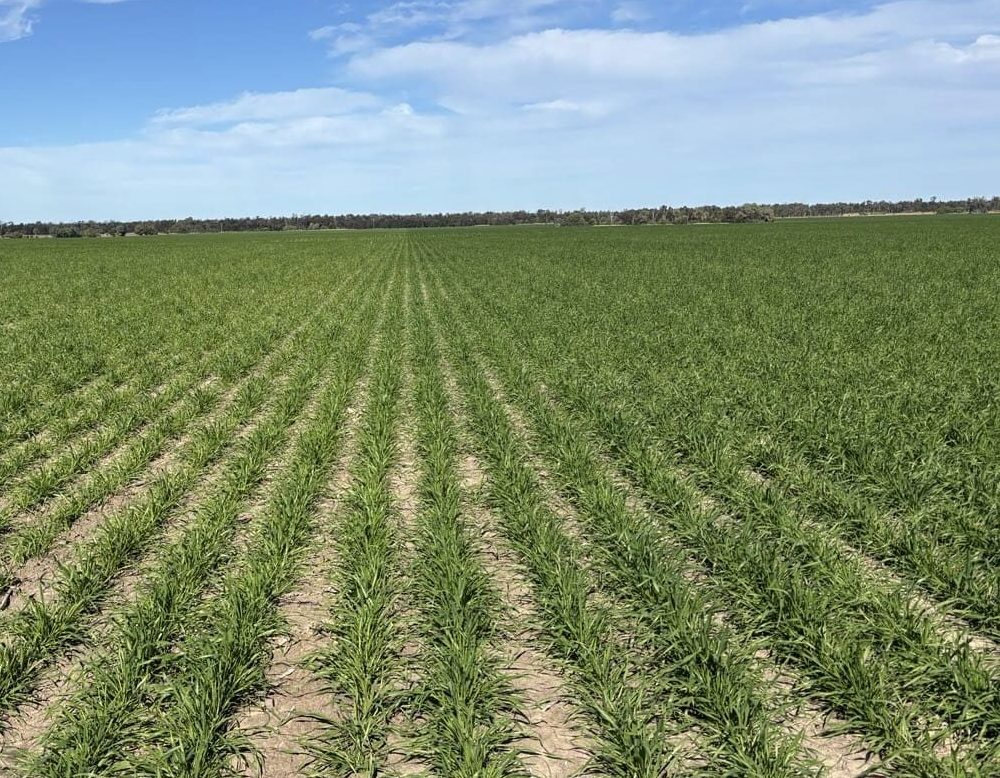
A crop of wheat in the Moree district of northern NSW sown early May. Photo: Ben Boughton
A RALLY in offshore wheat prices has kicked local values higher and sparked a surge in traded volumes as cautious optimism about south-eastern Australia’s season builds.
However, barley gains have been more modest, with little bulk out of eastern Australia left to sell, and up-country demand still strong as livestock producers stock up for their last weeks of supplementary feeding.
Ahead of the new financial year, growers in the north are keen to price volume, and liquidity within the trade has picked up amid mostly ideal growing conditions in Queensland and the northern half of New South Wales.
| Prompt June 12 | Prompt today | New-crop June 12 | New-crop today | |
| Barley Downs | $330 | $327 | $330 Jan | $330 |
| ASW Downs | $335 | $343 | $335 Jan | $345 |
| Sorghum Downs | $350 | $352 | NQ | NQ |
| Barley Mel | $365 | $368 | $358 | $360 |
| ASW Mel | $368 | $372 | $373 | $378 |
Table 1: Indicative prices in Australian dollars per tonne.
Growers keener to sell in north
Grower interest in selling wheat has lifted, largely in response to the recent rally in international values.
The past month has brought enough rain to keep cereals on track for at least an average yield, and crop establishment has generally been good to excellent.
However, some pockets around Walgett on the north-west plains of NSW and the Liverpool Plains west of Tamworth, are too wet in places.
“Local markets are up on higher international values,” Agvantage Commodities broker Brendon Warnock, Narrabri, said.
With consumers generally well covered for feed wheat and barley, traded volume has been thin in recent weeks.
“Today they have a stronger tone, and the delivered-packer market is up.”
Conflict between Israel and Iran and what that could mean for global energy and grain markets was at the centre of the overnight wheat rally.
The move has growers picking up the phone to sound out bids, with some showing interest in pricing current-crop parcels of up to 1000t or more.
The improved seasonal outlook for Victoria, South Australia, and southern NSW, has also prompted the northern holder of on-farm or warehoused grain to consider selling.
“There was a pretty strong leg of support from the south, where we’re seeing some rain but not huge amounts.”
Mr Warnock said some growers were showing interest in multigrade contracts for new crop as the growing season kicks along.
“Growers in our neck of the woods are pretty happy.”
On cottonseed, values continue to trade in a narrow range around $420/t ex Gwydir Valley gin and $415/t ex Namoi Valley gin.
“There’s not much export business happening, and domestics are comfortable where they are for the moment,” Woodside Commodities managing director Hamish Steele-Park said.
In southern NSW, cottonseed ex gin is trading at $455/t and the Macquarie Valley market in central NSW is around $430/t.
More patchy rain in south
Some short covering of wheat for bulk export generated a spike in the Vic market this week, where traded volume continues to centre on drought feeding.
The call on that front is mostly for barley and corn, and extends into SA, where bulk handlers are supplying volume needed by those with sheep, beef cattle, and dairy herds to feed.
Up-country sites throughout SA, Vic and NSW have ample grain to out-turn to livestock producers, and further demand continues to come from stockfeed and pellet manufacturers who are selling into the drought market.
This demand is expected to ease by September, when sheep and cattle should be back on pasture, season permitting.
In the week to 9am today, SA farmers and graziers were lucky enough to get double-digit rain, and registrations include: Coulta 23mm; Bordertown, Cummins and Melrose 14mm; Lucindale 12mm, and Mintaro 15mm.
In Vic, parts of the Mallee once again missed out on the showers, which generally brought 4-8mm to cropping districts, in line with what was recorded in most inland SA gauges.
Many crops have emerged, but are not yet established, and need more rain by early July to improve their chances of average or better yields.
Watson Bulk Logistics managing director Joel Watson said some Vic growers may sell current-crop once July 1 ticks over.
“A lot of growers are sitting on their hands; they haven’t had enough rain to be encouraged to let things go,” Mr Watson said.
One trader said growers were barley in case the season takes a turn for the worse, but liquidity has picked up on wheat delivered consumer.
Grain Central: Get our free news straight to your inbox – Click here

HAVE YOUR SAY